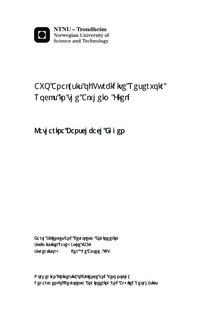| dc.contributor.advisor | Avseth, Per Åge | nb_NO |
| dc.contributor.author | Eggen, Katharina Banschbach | nb_NO |
| dc.date.accessioned | 2014-12-19T12:16:24Z | |
| dc.date.available | 2014-12-19T12:16:24Z | |
| dc.date.created | 2012-11-08 | nb_NO |
| dc.date.issued | 2012 | nb_NO |
| dc.identifier | 566232 | nb_NO |
| dc.identifier | ntnudaim:7522 | nb_NO |
| dc.identifier.uri | http://hdl.handle.net/11250/239802 | |
| dc.description.abstract | The Alvheim reservoir is a turbidite reservoir, which means that the complex deposition makes it a difficult reservoir to perform predictions regarding reservoir content on. In the preceding project work (Eggen 2012) AVO analyses were performed on the twelve modelled scenarios that can be present in a turbidite reservoir. These modelled scenarios were to be compared with the analyses performed on the real data in this master s thesis to see if the modelled scenarios can help to predict what answers to expect from the analyses performed on the real data. One post-stack data set consisting of Near and Far stacks covering the whole Alvheim field including all three hydrocarbon discoveries, and one pre-stack data set focusing on the oil discovery named Kneler were available for this thesis in addition to well logs from well 25/4-7. Naturally, it was the Kneler oil discovery that was focused on, and on the gathers from the pre-stack data the top reservoir could be identified by a clear AVO effect. Different AVO analyses were performed on this AVO effect and the results were compared with the results obtained from the project work. In addition to performing AVO analyses on the data it was interesting to see if it was possible to see how the reservoir changed when moving away from the well location on the seismic data. To increase the signal to noise ratio, super gathers around the well location were created in addition to super gathers at some distance away from the well to see if there were changes that were noticeable on the seismic.The AVO analysis was performed on the top oil sand (top reservoir) in the Heimdal Member located in the Lista Formation. An AVO crossplot was created from both data sets, where the area around the Kneler discovery was picked by hand on the post-stack data set to match the area that was plotted from the pre-stack data. The crossplot created from the post-stack data showed the best deviation from the background trend out of the two, and the anomaly could be classified as a class III AVO anomaly. It was also performed an AVO gradient analysis on the AVO effect on a pre-stack seismic gather and on a synthetic seismic gather created with a normal Ricker wavelet and velocities taken from well 25/4-7. Both AVO curves from these analyses had a negative intercept and a negative gradient, which also could classify them as a class III AVO anomaly. It was known in advance that the upper part of the reservoir consisted of unconsolidated interbedded sand-shale and it was expected that the results would match the results obtained from the modelled scenario of the unconsolidated interbedded sand-shale. However, this was not completely the case and the results from the analyses of the real data turned out to match the analyses for the modelled unconsolidated massive sandstone. Even if the analyses from this master s thesis do not match the expected analyses performed in the preceding project work, they can be said to be correct. The error in comparison is due to the fact that the analyses in this master s thesis are performed on the top of a section of unconsolidated interbedded sand-shale, but the top layer is actually a layer of unconsolidated massive sandstone. This means that when making assumptions it should not be taken for granted that the real data will match the modelled data, especially not if there are uncertainties related to the assumptions the modelling is based on. | nb_NO |
| dc.language | eng | nb_NO |
| dc.publisher | Institutt for petroleumsteknologi og anvendt geofysikk | nb_NO |
| dc.subject | ntnudaim:7522 | no_NO |
| dc.subject | MTGEOP Geofag og petroleumsteknologi | no_NO |
| dc.subject | Petroleumsgeofysikk | no_NO |
| dc.title | AVO Analysis of Turbidite Reservoir Rocks in the Alvheim Field | nb_NO |
| dc.type | Master thesis | nb_NO |
| dc.source.pagenumber | 87 | nb_NO |
| dc.contributor.department | Norges teknisk-naturvitenskapelige universitet, Fakultet for ingeniørvitenskap og teknologi, Institutt for petroleumsteknologi og anvendt geofysikk | nb_NO |

